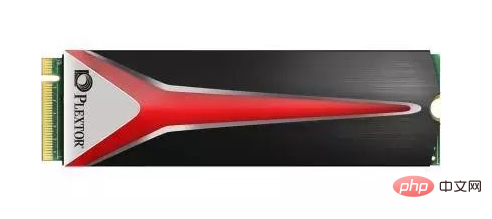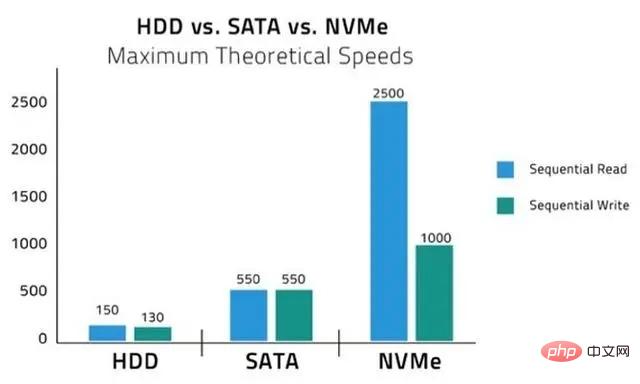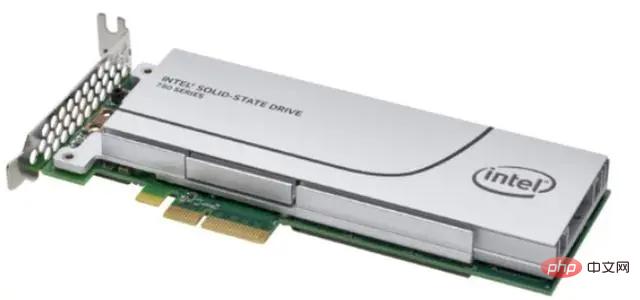What is nvme hard drive?
nvme is a solid state drive; it is a specification for solid state drives using PCI-E channels. The purpose of the nvme specification is to make full use of the low latency and parallelism of the PCI-E channel, as well as the parallelism of contemporary processors, platforms and applications, to greatly improve the read and write performance of solid-state drives at controllable storage costs. Reduce the high latency caused by the AHCI interface and completely unleash the ultimate performance of solid-state drives in the SATA era.

The operating environment of this tutorial: Windows 7 system, Dell G3 computer.
NVMe is actually a logical device interface standard like AHCI. NVMe is a specification for solid-state drives that use PCI-E channels. At the beginning of the design, NVMe took full advantage of the low latency and parallelism of PCI-E. sex. Its most obvious advantage over traditional solid-state drives using SATA channels is its ultra-high read and write speeds.
NVMe is the abbreviation of Non-Volatile Memory express (Non-Volatile Memory Host Controller Interface Specification). It is a protocol that enables solid-state drives (SSD) to run faster. It is now used by enterprise users has become increasingly popular.
The easiest way to understand what NVMe is is to use an analogy - suppose you just bought a sports car that can reach a speed of 400 kilometers per hour, which is 3 to 4 times that of your previous old car. . The only problem is that ordinary roads cannot allow driving at such a speed, and the speed limit on urban roads is usually dozens of kilometers per hour, and traffic flow issues often have to be considered. If you want your sports car to go faster, you need to drive it another way.
This scenario is a bit like the situation in the storage industry after manufacturers launched SSDs based on flash memory technology. Flash technology is many times faster than traditional mechanical hard drives (how many times faster depends on the device you use), but early devices all used the same SATA or SAS connections as hard drives to connect to systems and networks. While these interfaces are adequate for the performance a hard disk drive (HDD) can provide, they create bottlenecks for SSDs. This is especially a problem for enterprise big data analytics and other data-intensive workloads.
These performance issues have prompted people to look for better ways to connect SSDs to servers, which is where NVMe comes in.

1. What is NVMe?
The NVMe protocol standard is overseen by NVM Express, a group of more than 100 organizations A consortium of organizations working to develop faster protocols to improve the performance of non-volatile storage. The organization is led by a 13-company board of directors, including Cavium, Cisco, Dell EMC, Facebook, Intel, Micron, Microsemi, Microsoft, NetApp, Samsung, Seagate, Toshiba Memory and Western Digital.

The highest theoretical speed that HDD can achieve, compared with the highest theoretical speed provided by SATA and NVMe
The official definition of NVMe describes it as "an open A collection of standards and information to fully unlock the benefits that non-volatile storage can provide in all types of computing environments, from mobile to data centers. NVMe is designed from the ground up to provide high bandwidth and performance for current and future NVM technologies. Low-latency storage access."
NVMe is an interface specification for connecting storage to servers through the PCI Express bus. Simply put, it allows SSDs to communicate with the host system faster. It helps alleviate bottlenecks that occur when flash memory is connected to the system via SAS or SATA, which were originally designed for HDDs.
2. NVMe is much faster than SATA or SAS
NVMe controllers improve performance in several different ways. One is to use the PCIe bus, which connects storage directly to the system CPU. This direct connection eliminates some of the necessary steps for SATA and improves overall performance.
In addition, NVMe SSD achieves parallelism to a large extent, greatly improving throughput. When data is transferred from storage to the server host, it enters a row or queue. Traditional SATA connections can only support one queue and can only receive 32 pieces of data at a time. Going back to the car analogy, it's like having only one lane of traffic for 32 cars.
NVMe storage supports up to 64,000 queues, each with 64,000 entries. In other words, it's like going from a one-way street to a road with 64,000 lanes, each of which can accommodate 64,000 cars, which has a huge impact on overall performance.
Just like our analogy said that urban roads generally have speed limits of tens of kilometers per hour, SATA and SAS connections also have speed limits. For SATA, the theoretical maximum transfer speed is 6.0 Gbps (in practice, the maximum transfer speed is much lower). This is equivalent to setting an upper limit on the operating speed of SATA SSD. Beyond a certain limit, using faster flash memory has no impact on the overall performance of the system because the SATA connection will create a bottleneck.
For most consumers, SATA SSDs provide enough performance to get through daily tasks. And because SATA SSDs are cheaper than NVMe SSDs, most consumer-grade solid-state storage still uses the SATA interface.
However, businesses typically handle much more data than consumers, and for them, the latency introduced by a SATA connection can become an issue.

The Intel 750 series is one of the solid state drive products that supports NVMe technology
3. Only SSD runs on NVMe
Because NVMe The drive is much faster than SATA, so using NVMe alongside an HDD to improve performance seems like a good idea. But keep in mind that NVMe stands for Non-Volatile Storage Interface Specification, and it's designed specifically for non-volatile storage like NAND flash (although it can also be used with newer non-volatile memories like 3D XPoint).
When the system reads data from the HDD, it can only read one piece of data at a time. Because it has to rotate to get to the correct physical location for the first block, then rotate again to move to the correct location for the second block, and so on. Flash memory and other non-volatile storage technologies, on the other hand, have no moving parts. This means the system can read data from many different locations simultaneously. This is why SSDs can take advantage of the parallelism provided by NVMe, but HDDs cannot.
4. PCIe and NVMe are related, but they are not the same thing
For many people, the most confusing part of NVMe is its relationship with PCIe. Some vendors use the NVMe label to refer to their SSDs, others use the PCIe label, and still others seem to use the terms interchangeably.
While PCIe and NVMe are closely related, the two terms refer to slightly different technologies. Think of PCIe as the physical part of the system. When you plug an NVMe SSD into a server, you need to connect it through a PCIe slot.
In contrast, NVMe is a protocol, a set of software and hardware standards that allow SSDs to use the PCIe bus. Suffice to say, NVMe is the language that allows storage devices to connect to servers, while PCIe is the actual physical connection.
5. NVMe-oF connects SSD to the network
This article mainly focuses on standard NVMe, which connects SSD directly to the server, but the NVM Express organization also released NVMe over Fabric (NVMe - oF) specification that connects non-volatile storage for block storage to the network. According to the organization, "NVMe-ofF defines a common architecture that supports a range of storage network fabrics for the NVMe block storage protocol on top of the storage network fabric." This includes enabling front-end interfaces in the storage system, extending Large numbers of NVMe devices and extending the reach of NVMe devices and NVMe subsystems within the data center.
The NVMe-oF specification is approximately 90% identical to the NVMe specification; however, it does use a different transport mapping mechanism. NVME-oF also comes in two different variants: one for RDMA and one for Fiber Channel.
The NVMe-oF specification is also much newer than the NVMe specification. Although some manufacturers have announced support for this technology, few manufacturers actually sell NVMe products. Expect this technology to become more common in the coming years.

For more related knowledge, please visit the FAQ column!
The above is the detailed content of What is nvme hard drive?. For more information, please follow other related articles on the PHP Chinese website!

Hot AI Tools

Undresser.AI Undress
AI-powered app for creating realistic nude photos

AI Clothes Remover
Online AI tool for removing clothes from photos.

Undress AI Tool
Undress images for free

Clothoff.io
AI clothes remover

AI Hentai Generator
Generate AI Hentai for free.

Hot Article

Hot Tools

Notepad++7.3.1
Easy-to-use and free code editor

SublimeText3 Chinese version
Chinese version, very easy to use

Zend Studio 13.0.1
Powerful PHP integrated development environment

Dreamweaver CS6
Visual web development tools

SublimeText3 Mac version
God-level code editing software (SublimeText3)

Hot Topics
 Samsung to launch PM1753 data center-grade SSD: 14.8 GB/s sequential read, 3.4 million IOPS random read
Aug 08, 2024 pm 04:40 PM
Samsung to launch PM1753 data center-grade SSD: 14.8 GB/s sequential read, 3.4 million IOPS random read
Aug 08, 2024 pm 04:40 PM
According to news from this site on August 8, Samsung demonstrated a variety of new SSD products at the 2024 Flash Memory Summit (FMS) - PM1753, BM1743, PM9D3a, PM9E1, and also tested the ninth generation QLCV-NAND, TLCV-NAND and CMM-D –DRAM, CMM-HTM, CMM-HPM, and CMM-BCXL technologies were introduced. BM1743 uses QLC flash memory with a capacity of up to 128TB, a continuous read speed of 7.5GB/s, a write speed of 3.5GB/s, a random read of 1.6 million IOPS, and a write of 45,000 IOPS. It adopts a 2.5-inch form factor and a U.2 interface, and is idle Power consumption is reduced to 4W, and after subsequent OTA updates, only
 VBOX_E_OBJECT_NOT_FOUND(0x80bb0001)VirtualBox error
Mar 24, 2024 am 09:51 AM
VBOX_E_OBJECT_NOT_FOUND(0x80bb0001)VirtualBox error
Mar 24, 2024 am 09:51 AM
When trying to open a disk image in VirtualBox, you may encounter an error indicating that the hard drive cannot be registered. This usually happens when the VM disk image file you are trying to open has the same UUID as another virtual disk image file. In this case, VirtualBox displays error code VBOX_E_OBJECT_NOT_FOUND(0x80bb0001). If you encounter this error, don’t worry, there are some solutions you can try. First, you can try using VirtualBox's command line tools to change the UUID of the disk image file, which will avoid conflicts. You can run the command `VBoxManageinternal
 Esidak launches MB204MP-B four-bay M.2 solid-state drive box: supports PCIe 5.0, 2399 yuan
Jul 22, 2024 am 11:55 AM
Esidak launches MB204MP-B four-bay M.2 solid-state drive box: supports PCIe 5.0, 2399 yuan
Jul 22, 2024 am 11:55 AM
This website reported on July 22 that ICEDOCK launched the ExpressSlotMB204MP-B four-bay M.2 solid-state drive extraction box on the 19th of this month. The extraction box adopts the shape of a PCIeAIC add-on card, requires PCIe6Pin auxiliary power supply, has a three-dimensional dimension of 204.5×21.59×126.9 (mm), supports the PCIe5.0 protocol, and can provide 16GB/s PCIe5.0×4 full-speed bandwidth for each solid-state drive. . Esidak ExpressSlotMB204MP-B SSD extraction box is compatible with M.22230/2242/2260/2280 SSDs. However, the thickness of each side of these SSDs must not exceed 1.5mm.
 SK Hynix demonstrates Platinum P51 SSD: sequential read peak 13500 MB/s
Mar 20, 2024 pm 02:36 PM
SK Hynix demonstrates Platinum P51 SSD: sequential read peak 13500 MB/s
Mar 20, 2024 pm 02:36 PM
According to news from this website on March 20, SK Hynix recently attended the NVIDIA GTC2024 conference and demonstrated the first Gen5NVMe solid-state drive series for the consumer market-Platinum P51M.22280NVMeSSD. PlatinumP51 is similar to GoldP31 and PlatinumP41. It uses a self-designed SSD master control, but the main highlight is the use of PCIeGen5 and 238-layer TLCNAND flash memory. Note from this site: Hynix acquired SSD master control manufacturer LAMD in 2012, giving it the ability to design its own master control. SK Hynix said at the booth that Platinum P51 will be launched in 500GB, 1TB and 2
 Phison comprehensively showcases Pascari enterprise-class SSD products, including 100DWPD ultra-high endurance model
Aug 07, 2024 pm 06:58 PM
Phison comprehensively showcases Pascari enterprise-class SSD products, including 100DWPD ultra-high endurance model
Aug 07, 2024 pm 06:58 PM
According to news from this site on August 7, Phison fully demonstrated its Pascari enterprise-class solid-state drive product line at the FMS2024 Summit. This product line covers 5 major categories and is targeted at various enterprise-level and data center applications. Here is a brief introduction on this site: X Series - Best Performance Phison's X Series enterprise-class SSDs are "designed for extreme writing requirements." In addition to the first X200 family, Phison also launched two PCIe 4.0 products, X100P and X100E, respectively 1DWPD and 3DWPD, with maximum capacities of 32TB Note 1. Both X100P and
 Samsung introduces BM1743 data center-grade SSD: equipped with v7 QLC V-NAND and supports PCIe 5.0
Jun 18, 2024 pm 04:15 PM
Samsung introduces BM1743 data center-grade SSD: equipped with v7 QLC V-NAND and supports PCIe 5.0
Jun 18, 2024 pm 04:15 PM
According to news from this website on June 18, Samsung Semiconductor recently introduced its next-generation data center-grade solid-state drive BM1743 equipped with its latest QLC flash memory (v7) on its technology blog. ▲Samsung QLC data center-grade solid-state drive BM1743 According to TrendForce in April, in the field of QLC data center-grade solid-state drives, only Samsung and Solidigm, a subsidiary of SK Hynix, had passed the enterprise customer verification at that time. Compared with the previous generation v5QLCV-NAND (note on this site: Samsung v6V-NAND does not have QLC products), Samsung v7QLCV-NAND flash memory has almost doubled the number of stacking layers, and the storage density has also been greatly improved. At the same time, the smoothness of v7QLCV-NAND
 Yangtze Memory QLC flash memory X3-6070 has a write and erase life of 4,000 times, catching up with TLC products
Mar 28, 2024 pm 03:26 PM
Yangtze Memory QLC flash memory X3-6070 has a write and erase life of 4,000 times, catching up with TLC products
Mar 28, 2024 pm 03:26 PM
News from this site on March 28, according to Taiwanese media DIGITIMES, Yangtze Memory stated at the China Flash Memory Market Summit CFMS2024 that the X3-6070QLC flash memory using third-generation Xtacking technology has achieved a P/E endurance of 4,000 times. Note from this site: Different from the warranty life, consumer-grade original TLC solid-state drives generally have at least 3,000 P/E-level erase and write life in tests. ▲Image source China Flash Memory Market Summit CFMS official, the same below Huo Zongliang, CTO of Yangtze Memory, said that the NAND flash memory industry has passed the most difficult year of 2023 and will enter a rising period this year. It is expected that the total flash memory demand will grow at a compound rate from 2023 to 2027. The rate can reach 21%, and the average capacity of a single device is
 Kingston NV3 M.2 SSD is on sale in China: optional 512G-2TB, reading speed 5000 MB/s, starting from 319 yuan
Aug 12, 2024 pm 01:36 PM
Kingston NV3 M.2 SSD is on sale in China: optional 512G-2TB, reading speed 5000 MB/s, starting from 319 yuan
Aug 12, 2024 pm 01:36 PM
According to news from this site on August 12, Kingston NV3M.2 SSD is currently on sale on JD.com. The SSD is available in 512GB (500GB)/1TB/2TB versions (the 4TB version is not on the shelves). Its main reading speed is 5000MB/s. The price information compiled by the website is as follows: 512GB: 319 yuan 1TB: 449 yuan 2TB: 929 yuan Kingston NV3 adopts single-sided M.22280 size, suitable for laptops, equipped with PCIe4.0x4 controller, the read and write speeds of this website are as follows: 512GB: 5000 /3000MB/s1TB: 6000/4000MB/s2TB: 6000/5000MB/s Kingston will provide a 3-year limited warranty for NV3 SSDs





